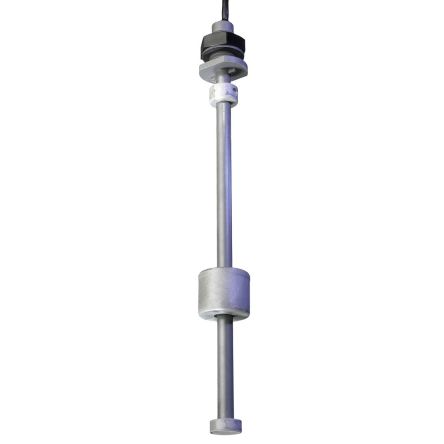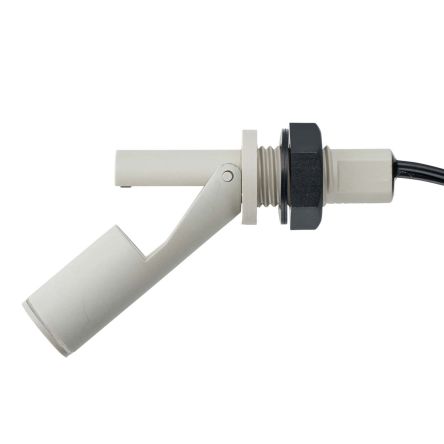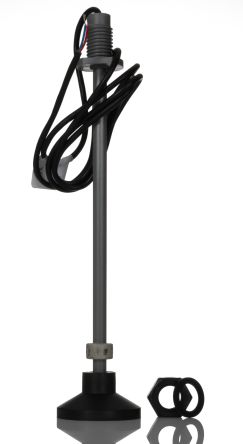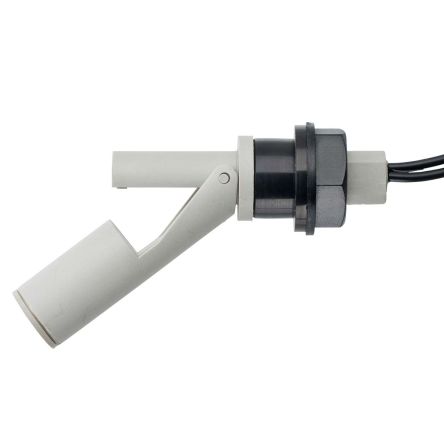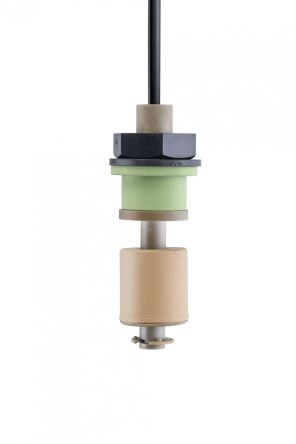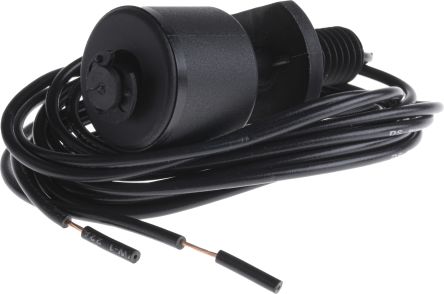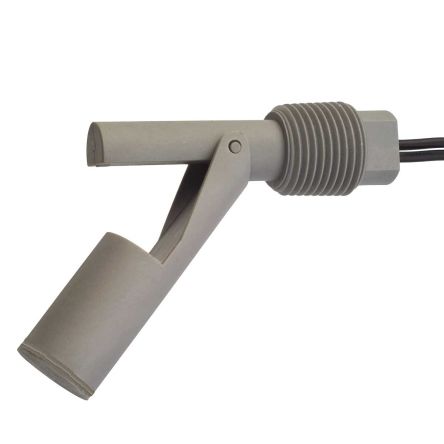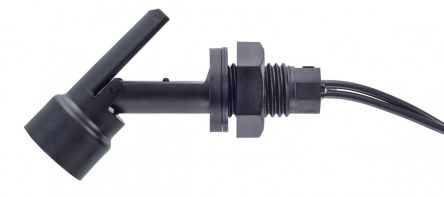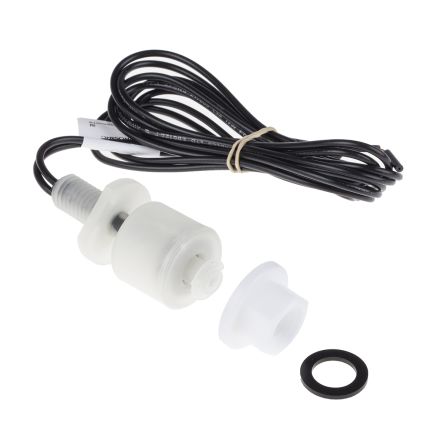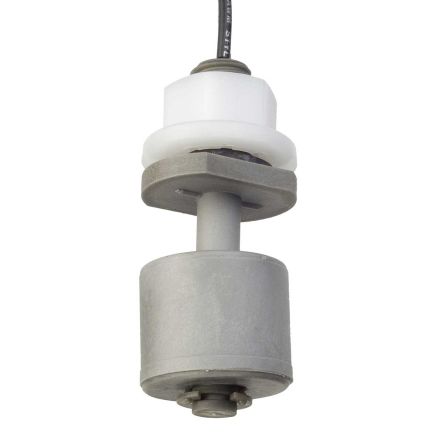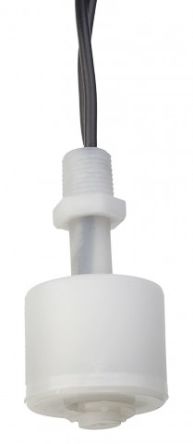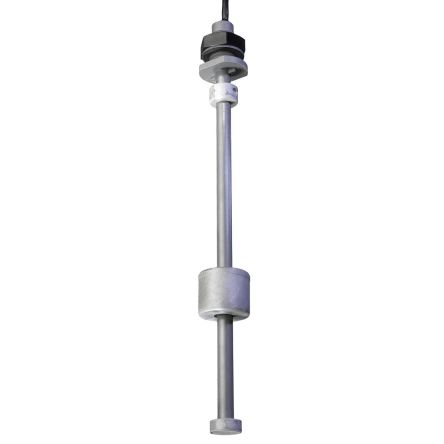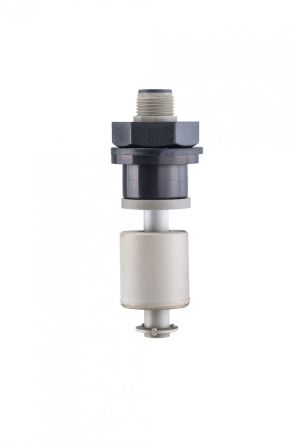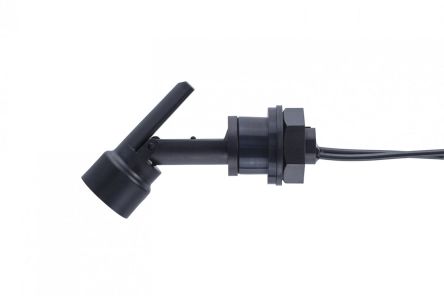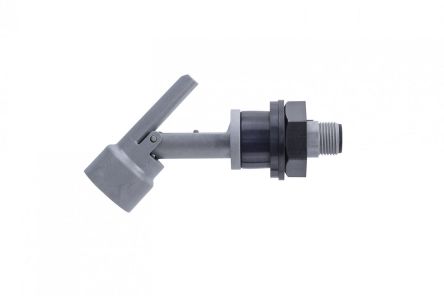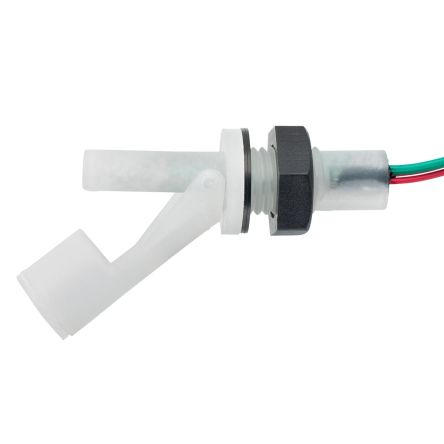- Automation & Control Gear
- Cables & Wires
- Enclosures & Server Racks
- Fuses & Circuit Breakers
- HVAC, Fans & Thermal Management
- Lighting
- Relays & Signal Conditioning
- Switches
- Batteries & Chargers
- Connectors
- Displays & Optoelectronics
- ESD Control, Cleanroom & PCB Prototyping
- Passive Components
- Power Supplies & Transformers
- Raspberry Pi, Arduino, ROCK, STEM Education & Development Tools
- Semiconductors
240V Float Switches
A float switch or float level sensor detects the level of liquid, usually in a tank, container, or well. The flotation part of the level switch sits on top of the liquid and will switch on the rise and fall of the liquid. Float switches are used for automatic level control of groundwater, wastewater, and sewage pumps, for raw water and liquid transfer pumps at waterworks, and for high water alarms.
How does a Float Switch work?
Float switches have a reed switch and a pivoted magnet and can be used for normally open (N/O) or normally closed (N/C) operations. The switch action can be reversed rotating the switch through 180°.
The float sensor stays on top of the water, and the changing fluid level causes the float level switch to trigger (for instance, close or open) at a specific level. The internal mechanical switch opens or closes the electrical circuit with gravity, enabling it to turn equipment, such as a water pump, on and off. In Australia, float switches are used in enhancing wastewater treatment.
Vertical Float Switch: As an excellent solution for scenarios where access and space are limited, these mechanical float switches easily mount on any tank's top or bottom. Their minimal design includes a magnet in the float and a reed switch in the unit, fitting into small tanks wherever precise level monitoring is required.
Horizontal Float Switch: This switch is ideal for side mounting through the tank wall. It is equipped with a hinged float that moves in response to water level changes, similar to the vertical type but designed for easy access from the side. This makes it suitable for applications where top or bottom mounting is not feasible, such as large water level monitoring systems.
Cable End Float Switch: Cable end float switches are used in more challenging environments, particularly in pumping applications. They are designed to handle high-voltage settings up to 240v, making them perfect float switches for industrial waste systems to operate as water level switches. They feature a rugged design that is not only water-resistant but also capable of withstanding the heavy turbulence and wear typical in sewer systems.
Optical Level Sensor: These level sensors provide a high-tech solution for detecting fluid levels without any physical contact. Using an infrared LED and a phototransistor, they can detect the presence of liquids and are particularly useful in clear liquid applications. They offer a clean, noninvasive method for fluid level detection, ensuring maintenance-free operation in sensitive or sterile environments.
Hydrostatic Level Sensor: For precise and continuous level measurement in various liquid applications. These float switches are ideal for small and large-scale environments, from pumps to large reservoirs. Their ability to operate effectively across diverse conditions, including varying pressures and temperatures, makes them a versatile choice for comprehensive fluid level
Types of Materials and Applicable Usage
- Nylon – used for oils, diesel, and organic chemicals.
- Polypropylene (PP) – used with acids and alkali, detergents, oils, water, and organic chemicals.
- Polyphenylene sulphide (PPS) – used for more aggressive chemicals, and higher temperatures, up to 120ºC.
- Stainless steel – employed in the medical and food industries, suitable for hydraulic fluids and chemicals.
- Copolymer Polypropylene – utilised for applications requiring chemical resistance and structural integrity, particularly effective against a broad range of chemicals.
- Polyvinylidene Fluoride (PVDF) – chosen for its superior chemical resistance, particularly in harsh environments involving solvents, acids, and bases, suitable for high-temperature applications.
- Polyethylene (PE) – preferred for its excellent insulation properties and low moisture absorption, used in environments where cost-efficiency and chemical resistance are prioritised.
Selection on Considerations for Appropriate Type of Float Switch
It is vital to understand how the switch will be used when identifying the appropriate type of float switch. For example, there is a selection process for choosing and installing effective float switches for home ponds in Australia. The deciding factors to consider are:
- Fluid Level Requirement: Identify what triggers the float switch or level switch. It could be a single fluid level or multiple levels where the switch must activate.
- Electrical Specifications: Determine the electrical load the switch must handle. This includes voltage, current, and whether the load is resistive, capacitive, or inductive.
- Chemical Compatibility: Choose a float level switch made of materials that can resist the fluid type in your tank to prevent corrosion or degradation.
- Operating Conditions: Consider the working temperatures and pressures the float level switch will face.
- Installation Requirements: Decide on the mounting type — horizontal or vertical float switch and consider the installation space within the tank.
- Connections and Wiring: Choose the right cable length and type, and decide if you need a flying lead or a specific connector type.
- Certifications: Depending on your region or industry, ensure the switch meets necessary regulatory approvals, such as WRAS, ATEX, UL, or NSF.
- Maintenance Considerations: Factor in the potential for deposit build-up which might affect switch performance.
- Special Conditions: Where necessary, ensure the float level sensor can handle unique liquid characteristics like foam, particulates, or solids.
- Custom Requirements: If standard solutions don’t fit, look into customising your float switch to meet specific size, shape, or material needs.
It’s also worth noting that float switches are built to last, with some models functioning well over 20 years.
Features and Benefits of Float Switches
- Highly Flexible: Float switches adapt easily to various installations, ensuring versatility in confined spaces.
- High Mechanical Load Rating: Robust enough to withstand harsh conditions, prolonging operational lifespan.
- Insensitive to Turbulence: Assures stable performance, even with fluctuating fluid levels.
- Shock and Rupture Proof: Designed to resist sudden impacts and pressures, enhancing durability.
- WRAS approvals: All float switches qualify for the Water Regulations Advisory Scheme (WRAS) approval, adhering to the strict UK standards for safety and compliance in potable water applications.
Industrial Applications of Float Switches
Float Switches can be used in several situations, some of which include:
- Sump Pits
- Fuel Tanks
- Coolant Tanks
- Oil/Water Separators
- Wastewater and Sewage Treatment
Buying Monitoring Relays: Ordering & Delivery Information for Australia
RS is committed to being your trusted and preferred supplier for float switches and monitoring relays. We offer a diverse array made from top manufacturers, such as RS PRO, Gems Sensors, Sensata / Cynergy 3, WIKA, ATMI, and more. Implement holistic solutions with our other products, such as water flow meters, level sensors, or fluid pressure sensors.
RS ensures timely delivery across Australia, offering next-day service for orders placed by 5 pm AEST on weekdays. Note that some regions or specific items may experience longer delivery times.
Our intuitive platform ensures acquiring the float switches you need is straightforward and supported by efficient delivery options. Refer to our delivery page for more details.
